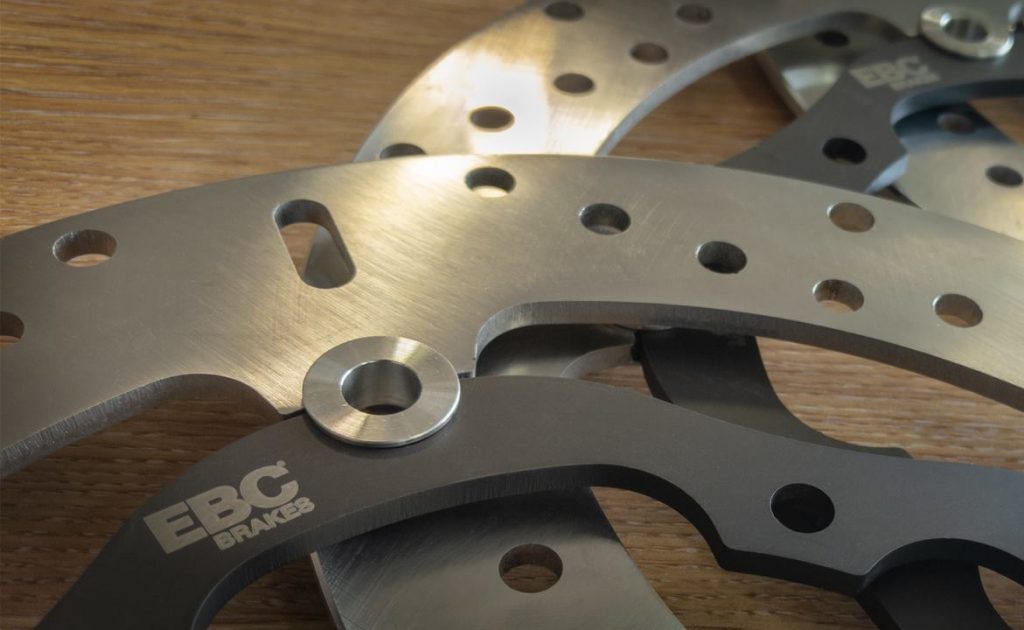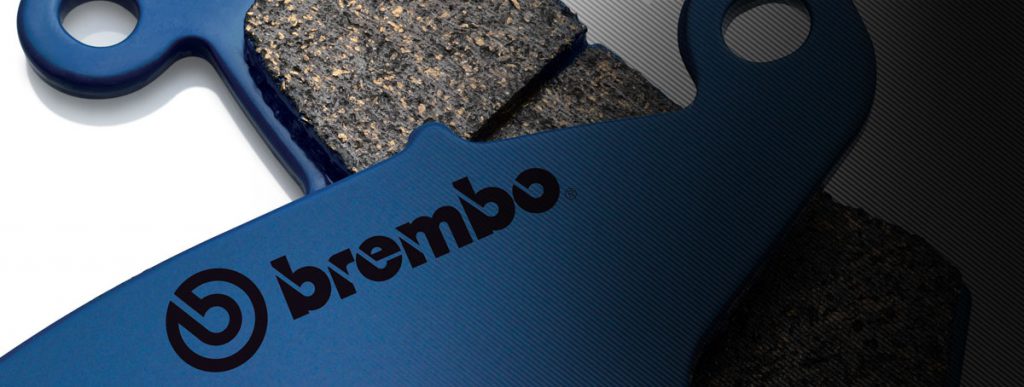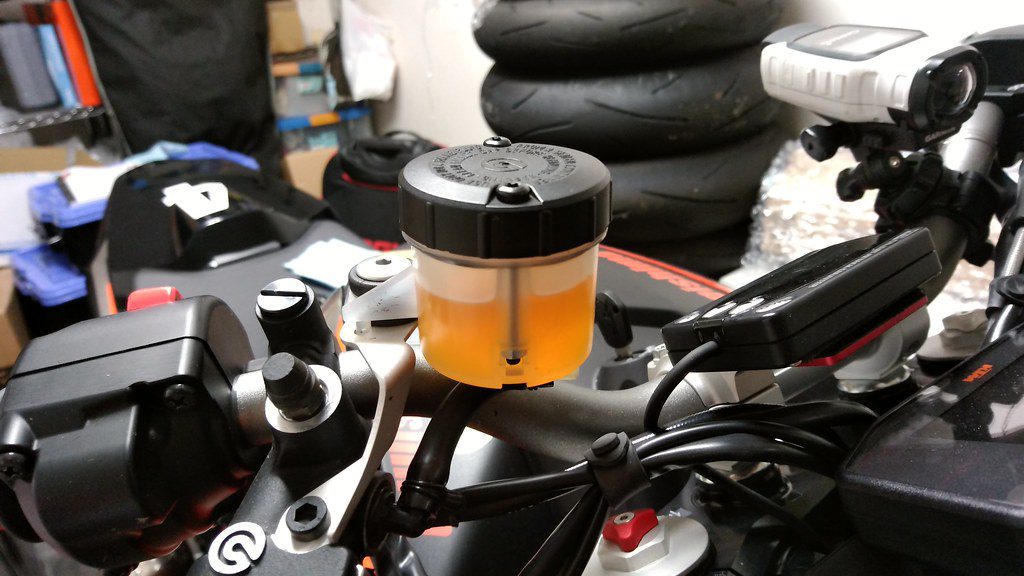
We all love getting out on our bikes in the summer, munching the miles, hitting the twisties – maybe even get a few laps in on a track day? If we see a bunch of bikes out and about, we all admire the work and effort that has gone into making each one personal to its rider – we see new exhausts, new wheels, different bodywork and the latest tyres from all the top brands. A quick stop then back on the road and on the throttle to get our next fix of adrenaline!! However, there are some products or upgrades we don’t notice…
Continue reading for everything you need to know on the best motorcycle brake upgrades, which will add serious performance to your next ride.
We all take note of the bling and love the speed, agility and buzz of riding a motorcycle; but when was the last time you stopped to take notice of a bike’s brakes? Some of us will have, but to a lot of us, they are only brought to our attention when we get an MOT advisory, or the guy fitting our tyres tells us that they need changing.
Let’s face it – we all need brakes! It’s good to get out on the road and open the taps every now and again, but we need to make sure we can stop – and the same goes for the track too! In fact, a few brake upgrades could actually save us a few seconds a lap!! We need to make sure our brakes are functioning as they should and give them as much love and attention as we do the rest of our bike!
Motorcycle brake discs

Apart from your brake pads – your brake discs are the most important components of your braking system! Aside from older, smaller bikes that may have had drum brakes at the front, pretty much all modern-day bikes now have disc brakes (some smaller machines maybe at the front only).
Disc brakes have evolved a long way since the early days of fixed rotors and sliding calipers – most bikes tend to use floating discs and fixed calipers these days – floating discs can avoid discs warping and reduce the heat transfer to the wheel hub. Brake disc design has also evolved a long way since the early days of motorcycle disc brakes, with numerous designs, such as a wavy disc from Galfer or Armstrong, to a more conventional looking disc like the Brembo Serie Oro or EBC X-Series disc. If you’re after something in between, then maybe the EBC X-series contour disc? Not a full wave design, but a little more interesting than a standard round disc.
Although motorcycle brake design has improved significantly over the years, they still need to be well maintained – a set of discs that are used properly, looked after and are mated to the right pads can happily go through two or 3 sets of pads before replacing them needs to be considered… (Obviously there will be certain occasions when you will need to replace your discs before they are worn out – for example if they are warped, or discoloured from too much heat etc.) If you have a twin disc set up on the front of your bike and need to change them, then you should replace both discs at the same time to avoid any brake efficiency or balance issues that could make the bike dangerous under braking.
Motorcycle brake pads

Your brake pads are probably the most important component of your motorcycles braking system. We can have the best discs in the world, trick levers etc., but if our pads aren’t working, we’re not stopping! Most of us will change our bike’s pads at some time in our ownership of it and it’s important to fit the best type of pads for our type of bike, as well as our type of riding. Most brake pads (road or track) can be split into 2 types of pad – sintered brake pads and organic brake pads.
Sintered brake pads, such as EBC HH or Brembo Sintered Road Pads are probably the most popular type of brake pads (over 90% of all new bikes now have sintered brake pads fitted as OEM equipment). Sintered brake pads work over such a wide range of operating conditions and able to cope with virtually anything a road rider would encounter.
Sintered pads are created by combining metallic particles into the pad friction material using extreme heat and pressure – in turn these particles create a compound which is highly consistent whether hot or cold and give good initial bite. Sintered brake pads can handle a lot of heat from prolonged or heavy brake use and will not fade anywhere near as much as a non-sintered pad. They also last longer the non-sintered pads as they are very hard wearing – the only downside to the performance benefits is that they put more wear on your brake discs! Sintered Race or track day pads, such as SBS Racing Sintered Pads offer awesome stopping power in the wet or dry, as well as giving the rider excellent feel and short bed in times. Due to the higher brake temperatures on a track, these pads are ceramic backed to reduce fade.
Non-sintered pads like the Armstrong GG Organic compound pad or Brembo Ceramic Road pads – as the name suggests have a pad compound that is a lot softer than a sintered brake pad and a lot of people prefer these pads for several reasons… An organic brake pad gives the rider a more “progressive” feel when the brakes are applied and do not have as much initial bite as a sintered brake pad – this can offer the rider better control and slower speeds and feel a lot more “rider friendly”.
As they are softer than sintered pads, they are also easier on your brake discs, produce less brake dust and are excellent value for money, as they are cheaper than their equivalent sintered pads. As with sintered brake pads, they do have their downsides too! Their softer compound means they will wear a lot quicker and they’re not as tolerant to heat and will not perform to their full potential if they get too hot.
There is a pad out there for all of us, it’s just picking the right one! As a rule, organic pads are more suited to lower powered, mid-range commuter bikes and scooters, whereas most bikes 600cc and above are suited to using sintered brake pads, due to the power and weight of the machines.
Brake fluids

Other parts of your bikes braking system that are often overlooked are your brake lines and brake fluid! Brake fluid is what is responsible for transmitting the force from your brake lever or pedal to your calipers. Brake fluid needs to be incompressible, have a low viscosity, a high boiling point and be good at lubricating master cylinder and caliper seals – that’s a hell of a lot of work for a fluid we very rarely think about! Brake fluid is available in 4 types/grades: DOT 3, 4, 5, and 5.1. DOT 5 is a silicone based brake fluid and very rarely used on motorcycles it MUST NOT be mixed with any DOT 3, 4 or 5 fluids which are Glycol based and used on 99% of most motorcycles. Glycol-based brake fluids are hygroscopic – meaning that they will absorb water over time reducing their effectiveness – reducing the boiling point and sometimes allowing air bubbles into the system.
In general, the lower the number, the lower the fluid’s boiling point – the only exception to this is DOT 5.1 fluid, as although it has a higher boiling point than DOT 4, it is more capable of meeting viscosity requirements at -40 degrees C than the others (something that we don’t really need to worry about in the UK). Most performance DOT 4 brake fluids like Castrol React Performance Dot 4 or Motul RBF600 have a boiling point as high as or higher than DOT 5.1. To overcome this, we recommend that you change your brake fluid at regular intervals, as specified by the manufacturer (every one-two years) – and if you have bought a new bike and are unsure how old the fluid is, then the colour of the fluid is a great indicator, as it should be a yellow translucent colour – the darker it looks, the older it is!
Braided brake lines
Finally, we need to look at our brake lines. We can have the best spec pads and discs in the world, but still have a “spongy” feel to our brakes? So, we bleed the brakes with fresh brake fluid, which makes a slight difference, but it’s still not 100%? Our brake lines over time will need changing or replacing, just like our pads or discs… Most motorcycles come from the factory and the OEM brake lines are made from rubber, which for the first three or four years are consistent performers, but over time, their performance can drop off (usually around the time that the discs and pads will be swapped), causing a few headaches and questions about the suitability of the parts we have fitted.
Over time the rubber in the hoses degrades and when the brake is applied, the hoses start to expand and do not transmit the force of the brake fluid as efficiently, giving that “spongy” feel to our brakes (the insides of the standard rubber lines can also degrade and contaminate our brake fluid too. Therefore, we would recommend fitting braided brake lines, such as Goodridge or HEL brake lines as soon as you can. Not only do they improve the look of your bike, but they also improve the performance of your brakes massively too!
Your standard rubber hose is replaced with a hose that has a stainless outer braid to stop the hoses expanding, as well as a low friction PTFE inner to aid fluid flow and reduce degrading over time – brake fade is greatly reduced, as is corrosion and abrasion resistance – but more importantly, braided lines remove the spongy feel and give us a firm, responsive brake lever that lets your discs and pads work properly and increase your confidence in them.
Most braided brake line kits are cheaper than OEM brake lines, come with a lifetime guarantee* (*for the time that you own the vehicle) and can be a nice styling upgrade too. All kits we sell have stainless steel banjos and bolts that do not corrode over time and most kits are available in a wide range of coloured sleeves to let you personalise your bike.
So, there we go! Not the most exciting subject to talk about or the most exciting product to look at, but we hope you agree that the brakes on your motorcycle are just as important as the go faster upgrades – and that we have helped to explain a little of what makes your brakes tick, how different options work – what motorcycle brake upgrades are available and what to look out for!
Enjoyed this? Read more of our latest news:
Where To Next?
Looking for the latest motorcycle parts and accessories? Check out our wide range from top brands.
Come and visit us at our store, showroom and fitting centre in Wrexham.
Want to know more about our story? Learn about who we are and why we’ve been driven by passion for over 50 years.
Interested in everything we do? Catch up on all the latest Demon Tweeks news.




